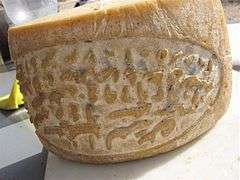Rumi cheese
Rumi cheese (Egyptian Arabic: جبنه رومى gebna rūmi [ˈɡebnæ ˈɾuːmi], also known as gebna romi or gebna turki [ˈtoɾki] in Alexandria) is one of the main types of cheese in Egypt. It has a pungent smell, and different degrees of saltiness depending on the age.[1]
| Rumi | |
|---|---|
 | |
| Country of origin | Egypt |
| Pasteurized | No |
| Texture | Hard/Crumbly |
| Weight | 10kg disks |
Description
Rumi is thought to be derived from the Greek kefalotyri cheese. It is the main hard cheese in Egypt.[2] It belongs to the same family as Pecorino Romano and Manchego.[3] Rumi cheese is made from cows' milk, or from a mixture of cow and buffalo milk. No starter culture is used.[4] The milk is natural, with full cream. Peppercorns may be added.[5] After 3–4 months the cheese develops an open texture and a sharp, pungent flavor.[6] Rumi is available in 10 kilograms (22 lb) disks or as slices with variable weight in vacuum packing.[5] There are 100 calories in an ounce serving, with about 28% saturated fat.[7]
Related products
The addition of low levels of PGE or lipases from R. miehei or R. pusillus has been reported to improve the flavor of Ras and Domiati cheeses.[8] In 1985 an experimental Ras cheese was made using equal amounts of cow and buffalo milk, with the addition or 20% to 30% of soy milk. The fat content was lower than natural cheese, and the flavor was affected slightly, but the result was said to have "satisfactory sensory properties."[9] Although the fermented cheese mish is traditionally made from Areesh cheese, commercial products similar to mish may be made from ras and domiati cheeses.[10]
See also
- Egyptian cuisine
- Areesh cheese
- Domiati
- List of cheeses
Notes
- African Cheese: Egypt.
- Fox 1999, p. 431.
- Fox et al. 2004, p. 11.
- Tamime 2011, p. 143.
- egyptian romy cheese: Agriculture source.
- Fontecha et al. 1990, p. 310.
- Egyptian Roomy Cheese...
- Fox 2000, p. 355.
- Shurtleff 2012, p. 237.
- Fox et al. 2004, p. 240.
References
- "African Cheese: Egypt". iFood. 2012. Archived from the original on 4 June 2013. Retrieved 4 March 2013.
- "egyptian romy cheese". Agriculture source. 2012. Archived from the original on 15 February 2013. Retrieved 4 March 2013.
- "Egyptian Roomy Cheese calorie and nutritional information". myfitnesspal. 2012. Retrieved 4 March 2013.
- Fontecha, Javier; Amigo, Lourdes; Angel de la Fuente, Miguel; Juarez, Manuela; Ramos, Mercedes; El-Shikh, Mohamed; El-Shibiny, Safinaz (Oct–Nov 1990). "Ripening changes in Ras cheese prepared from ultrafiltered milk". Zeitschrift für Lebensmittel-Untersuchung und -Forschung. 191 (4–5): 310. doi:10.1007/bf01202433.CS1 maint: ref=harv (link)
- Fox, P. F. (1999-08-01). Cheese: Chemistry, Physics and Microbiology (Major Cheese Groups). Springer. p. 431. ISBN 978-0-8342-1339-5. Retrieved 2013-04-15.CS1 maint: ref=harv (link)
- Fox, Patrick F. (2000-02-29). Fundamentals of Cheese Science. Springer. p. 355. ISBN 978-0-8342-1260-2. Retrieved 2013-04-15.CS1 maint: ref=harv (link)
- Fox, Patrick F.; McSweeney, Paul L.H.; Cogan, Timothy M.; Guinee, Timothy P. (2004-08-04). Cheese: Chemistry, Physics and Microbiology: Major Cheese Groups. Academic Press. ISBN 978-0-08-050094-2. Retrieved 2013-04-14.CS1 maint: ref=harv (link)
- Gunasekaran, Sundaram; Ak, M. Mehmet (2010-12-12). Cheese Rheology and Texture. CRC Press. p. 5. ISBN 978-1-4200-3194-2. Retrieved 2013-04-15.CS1 maint: ref=harv (link)
- Shurtleff, William (2012). History of Soy Yogurt, Soy Acidophilus Milk and Other Cultured Soymilks (1918-2012). Soyinfo Center. p. 237. ISBN 978-1-928914-47-1. Retrieved 2013-04-15.CS1 maint: ref=harv (link)
- Tamime, A. Y. (2011-05-03). "Cheese Flavours". Processed Cheese and Analogues. John Wiley & Sons. ISBN 978-1-4443-4183-6. Retrieved 2013-04-15.CS1 maint: ref=harv (link)
